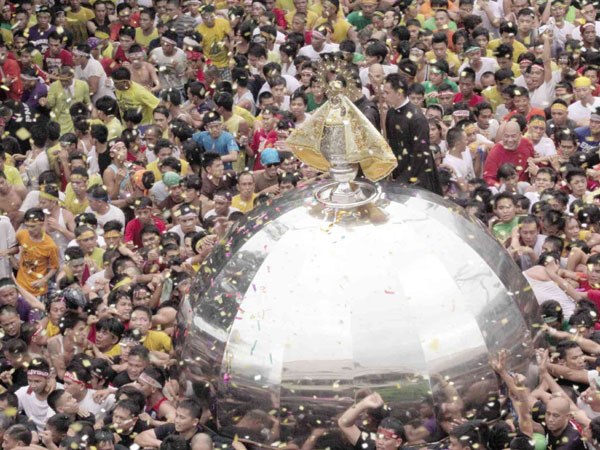
THOUSANDS of “voyadores” on Friday bring the replica of the 303-year-old image of Ina, Bicol patroness Nuestra Señora de Peñafrancia, from its shrine to Naga Metropolitan Cathedral. JUAN ESCANDOR JR. / INQUIRER SOUTHERN LUZON
NAGA CITY—A group of little boys sat down on the pavement across Porta Mariae, the main entrance to Naga Metropolitan Cathedral, to wait for their fathers on Friday afternoon to bring the image of Bicol patroness Nuestra Señora de Peñafrancia into the church, signaling the beginning of the weeklong fiesta in Naga City.
Mon, 5, who was too shy to say his full name, said they were told to wait there by his father who left to participate as “voyador” (male devotee) during the Traslacion procession of the 303rd celebration of Peñafrancia fiesta.
Although tradition has taught Bicolanos and devotees to keep their children away from the procession to protect them from physical harm due to the crowd that accompany the Bicol patroness, Mon and his friends were confident that nothing would befall them or their fathers this time.
The Traslacion procession, known to be one of the biggest Marian processions in Asia, has become popular for its devotees numbering close to a million, which in the past sometimes turned rowdy causing several minor accidents among participants.
Crowd
Allen Reondanga, spokesperson for the Naga City mayor, estimated the crowd during this year’s Traslacion procession to be 300,000.
But Fr. Louie Occiano, head of Caceres Commission on Communications under the Archdiocese of Caceres, placed the crowd, including the viewers and tourists, at almost a million. The festivities will end on Friday, Sept. 20.
The Traslacion procession involves the transfer of the images of Nuestra Señora de Peñafrancia, called Ina, and Divino Rostro (Holy Face of Jesus) from Peñafrancia Church through the main streets of Naga City to Naga Metropolitan Cathedral with help from the voyadores.
This Friday, the images would be transported via the Naga River to its official home, Basilica Minore, during the fluvial procession that would mark the end of the religious festivities.
Occiano said the conduct of Traslacion this year was more orderly because of the stricter security implemented by the local government and other agencies managing the procession flow.
Changes
Learning from the past, the city made several changes in the procession, including augmenting the security. Prior to the procession, different law enforcement agencies and other members of the Joint Operation Center (JOC) conducted a seminar to discuss a coordinated security system.
At least 1,058 members of the operation center composed of personnel from the police, military, Kabalikat-Civicom and Bureau of Fire Protection were deployed in the city, said City Police Director Jose Capinpin. Of this number, 600 were nurses and doctors manning 18 ambulances and health stations around key areas along the procession route.
Mayor John Bongat enforced a liquor ban during the Traslacion and during the fluvial procession to avoid rumbles among voyadores. This, Occiano explained, was to minimize injuries among devotees and damage to the images.
Among the changes implemented was the higher elevation of the images over an expanded “andas” and the setting up of wheels under it, which prevented voyadores from carrying the images on their shoulders, and discouraged rowdiness, he said.
Ban on vendors
A stricter implementation of the “no vendors” policy at Naga Metropolitan Cathedral and its surrounding streets was ensured by the local government and local security forces.
This is why children like Mon and his friends were able to sit on the sidewalk near the church that used to be teeming with vendors and voyadores. Bongat said the vendors were encouraged to sell their wares at Naga City People’s Mall or on the streets away from the church itself.
Estelita Borela, 75, and Shirley Boton, 57, members of Apostle of Prayer San Juan dela Cruz of Baao, Camarines Sur, said they believed the changes on the flow of the procession were enough to ensure the devotees’ safety.
“I’m old now,” Borela said. “I would be crushed if the old system was still in place.”
Solemn
Boton said the less chaotic atmosphere helped in keeping the tradition solemn.
However, George Purisima, 47, a voyador from Naga City, said this year’s Traslacion was “less orderly” because more groups who were not from Naga were organized to participate.
“They don’t have [the same] camaraderie as before,” he said. “Back then, we would talk and take turns under the andas. Now, I don’t know any of them.”
Jonathan Castillo, 18, was on his first year as a voyador. He said it was difficult but he would try again next year to show his devotion to Ina.
Occiano explained that
10 years ago, the archdiocese encouraged the voyadores to form their organization, Confradia de San Jose, to instill discipline among them.
Nonmembers were limited to following the primary voyadores at the back of the andas.
“They can still participate, even touch the andas, but we have set limits for them,” he said, as a way of keeping the flow of the procession peaceful.
The Traslacion tradition was believed to have begun during the colonial period under Bishop Francisco Gainza with the cimmarones, the natives of the old Naga City, and the Spaniards and friars of Bicol.
The Our Lady of Peñafrancia was the patroness of the cimmarones, who spread miracle stories.